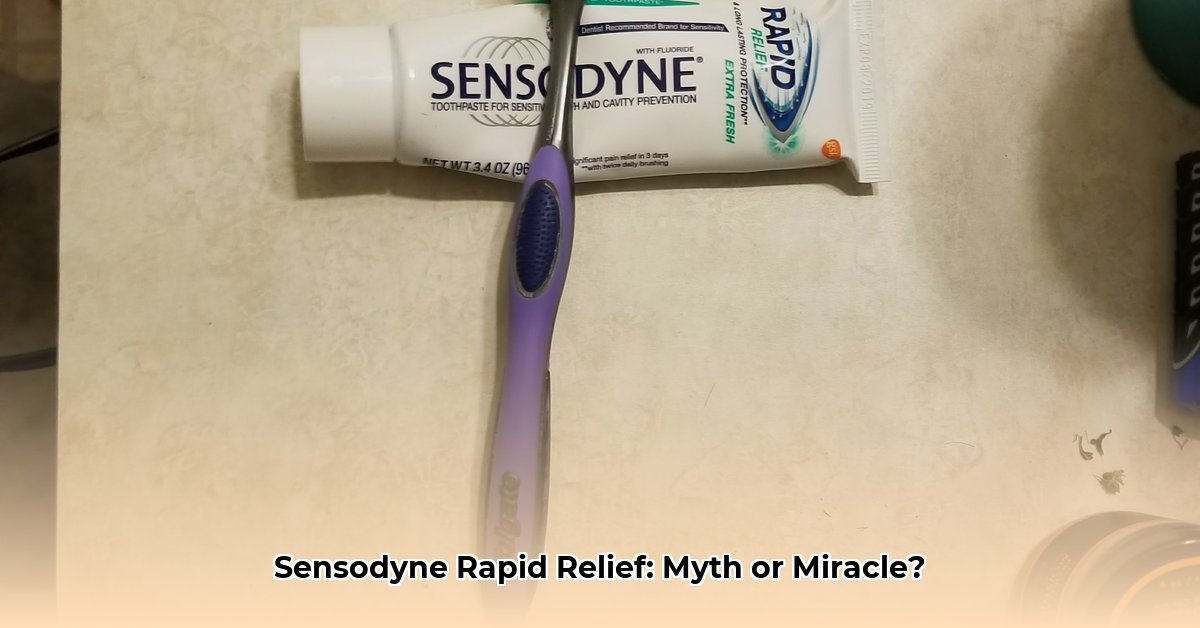
Sensitive teeth causing you haai? That sharp pang when you bite into something cold or hot is no joke. Many swear by Sensodyne Rapid Relief, but with different versions available, choosing the right one can be a mission. This article compares Sensodyne Rapid Relief and Sensodyne Rapid Relief Extra Fresh, examining their speed of action, ingredients, potential downsides, and ultimately, which is best for jou teeth. We'll unpack what causes sensitive teeth, how Sensodyne works, and when it might not be the ideal solution. Whether you need instant relief or longer-term protection, we'll provide the information you need to make an informed choice and find some peace from those sensitive teeth.
Understanding Sensitive Teeth and Sensodyne's Approach
Sensitive teeth are a common problem, often caused by exposed dentin (the layer beneath the enamel). This exposure allows stimuli like hot, cold, sweet, or acidic foods and drinks to reach the nerve endings within the tooth, causing pain. Sensodyne products aim to alleviate this by using desensitising agents that block these exposed tubules in the dentin. This prevents irritants from reaching the nerve and causing that sharp, unpleasant feeling. But how effective are they, and do the different versions really deliver on their claims?
Sensodyne Rapid Relief vs. Sensodyne Rapid Relief Extra Fresh: A Head-to-Head Comparison
Both Sensodyne Rapid Relief pastes utilise stannous fluoride, a key ingredient known for its desensitising properties. However, the formulations differ subtly, leading to variations in claimed speed of pain relief and overall taste. The original Sensodyne Rapid Relief claims 60-second pain relief, while the Extra Fresh version suggests clinically significant relief within three days. This discrepancy warrants further investigation.
Key Differences:
Speed of Relief: The original Sensodyne Rapid Relief boldly claims 60-second pain relief, while the Extra Fresh version suggests relief within three days of consistent use. Independent clinical trials are needed to verify these claims and fully understand the difference.
Ingredients: While both contain stannous fluoride, the Extra Fresh version incorporates additional ingredients such as glycerin for a smoother texture and different flavourings for its minty taste. These additional ingredients might impact the speed of pain relief or the overall sensation.
Taste: The Extra Fresh version notably differentiates itself with a stronger, minty flavour compared to the original, milder formulation. This should be considered alongside the speed of action, as individual preferences regarding taste will vary.
Potential Side Effects: Both pastes, due to the stannous fluoride, might cause slight staining of teeth with prolonged use. This possibility necessitates further research to determine the extent of staining between both versions.
| Feature | Sensodyne Rapid Relief | Sensodyne Rapid Relief Extra Fresh |
|---|---|---|
| Active Ingredient | Stannous Fluoride | Stannous Fluoride |
| Claimed Relief Time | 60 seconds | 3 days |
| Additional Ingredients | Proprietary Blend | Glycerin, Flavourings, and other ingredients |
| Taste | Mild | Strong Mint |
| Potential Side Effect (Staining) | Possible | Possible |
Choosing the Right Sensodyne Rapid Relief for You: A Practical Guide
The choice between Sensodyne Rapid Relief and Extra Fresh depends largely on personal preference. Do you need immediate relief, or are you prepared to wait for a more gradual reduction in sensitivity?
Consider these points:
Speed of Relief: If you need instant relief from the pain of sensitive teeth, the original Sensodyne Rapid Relief, with its 60-second claim (pending further verification), might be a better option. However, consistent use is key, even with the faster-acting version.
Taste Preference: If you prefer a strong minty flavour for your toothpaste, then the Sensodyne Rapid Relief Extra Fresh may be preferable. Those sensitive to strong mint flavours should consider the original version.
Long-Term Use: While both pastes provide relief from sensitive teeth, they primarily address the symptoms, not the underlying cause. Consistent twice daily brushing is recommended for both. Regular dental checkups for professional assessment and treatment of the root cause remain incredibly important, regardless of the chosen product.
Important Considerations and Next Steps
Both Sensodyne Rapid Relief variations aim to alleviate sensitive teeth but need more independent research to fully validate their claims. The differences in their claimed speed of relief and additional ingredients require rigorous testing to definitively determine their impact on efficacy and potential side effects. Moreover, further studies comparing staining potential between the two formulations would provide valuable insights for consumers.
Remember: Persistent or increased tooth sensitivity requires professional dental attention. These products address symptoms; a dentist can diagnose and treat the underlying cause. Regular dental check-ups are crucial for optimal oral health.